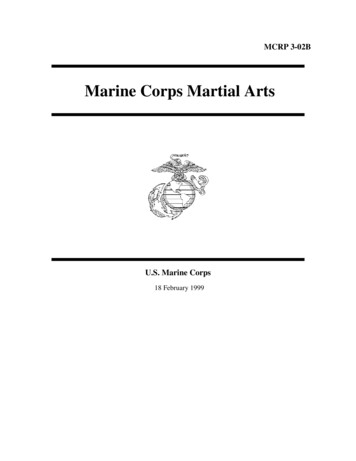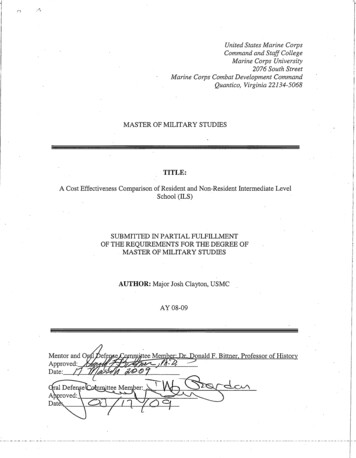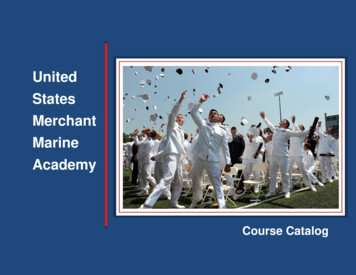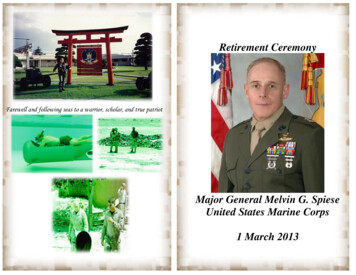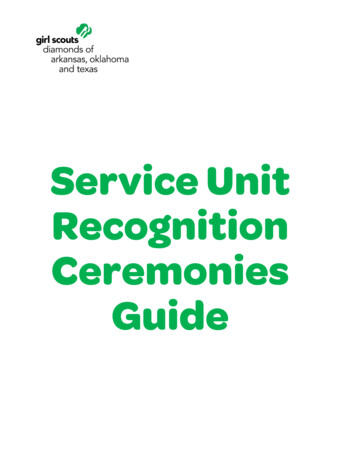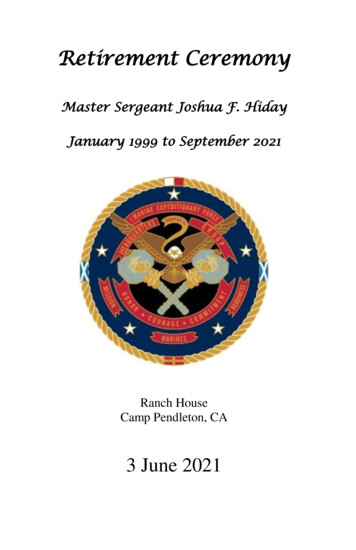
Transcription
Retirement CeremonyMaster Sergeant Joshua F. HidayJanuary 1999 to September 2021Ranch HouseCamp Pendleton, CA3 June 2021
The Commanding Officer of I MarineExpeditionary Force Information GroupWelcomes you to theRetirement Ceremony in honor ofMaster Sergeant Joshua F. Hidayafter 22 years of service to theUnited States Marine Corps
The Marines' HymnFrom the halls of Montezuma,To the shores of Tripoli;We fight our country's battlesIn the air, on land and sea;First to fight for right and freedomand to keep our honor clean;We are proud to claim the title ofUNITED STATES MARINE.Our flag's unfurled to every breezeFrom dawn to setting sun;We have fought in every clime and placeWhere we could take a gun;In the snow of far off northern landsAnd in sunny tropic scenes;You will find us always on the jobTHE UNITED STATES MARINES.Here's health to you and to our CorpsWhich we are proud to serve;In many a strife we've fought for lifeAnd never lost our nerve;If the Army and the NavyEver look on heaven's scenes;They will find the streets are guarded byUNITED STATES MARINES.
The Marines PrayerAlmighty Father, whose command is over alland whose love never fails, make me aware ofThy presence and obedient to Thy will. Keepme true to my best self, guarding me againstdishonesty in purpose in deed and helping meto live so that I can face my fellow Marines,my loved ones and Thee without shame orfear. Protect my family. Give me the will to dothe work of a Marine and to accept my shareof responsibilities with vigor and enthusiasm.Grant me the courage to be proficient in mydaily performance. Keep me loyal and faithfulto my superiors and to the duties my countryand the Marine Corps have entrusted to me.Make me considerate of those committed tomy leadership. Help me to wear my uniformwith dignity, and let it remind me daily of thetraditions which I must uphold. If I aminclined to doubt; steady my faith; if I amtempted, make me strong to resist; if I shouldmiss the mark, give me courage to try again.Guide me with the light of truth and grant mewisdom by which I may understand theanswer to my prayer.Amen.
SEQUENCE OF EVENTSInvocationNational AnthemReading of Retirement DocumentsSpouse RecognitionRetiring Officer’s RemarksMSgt Hiday’s RemarksOld Glory Presentation
The Staff Non-Commissioned Officer CreedI am a Staff Non-Commissioned Officer in theUnited States Marine Corps. As such, I am amember of the most unique group of professionalmilitary practitioners in the world. I am bound byduty to God, Country and my fellow Marines toexecute the demands of my position to and beyondwhat I believe to be the limits of my capabilities.I realize I am the mainstay of Marine Corpsdiscipline and I carry myself with military grace,unbowed by the weight of command, unflinchingin the execution of lawful orders and unswervingin my dedication to the most complete success ofmy assigned mission.Both my professional and personal demeanor shallbe such that I take pride if my juniors emulate meand knowing perfection to lie beyond the grasp ofany mortal hand, I shall yet strive to attainperfection that I may ever be aware of my needsand capabilities to improve myself.I shall be fair in my personal relations, just in theenforcement of discipline, true to myself and myfellow Marines and equitable in my dealing withevery man.
The Master Sergeant StoryOn 11 July 1798, the United States Marine Corps established thestaff noncommissioned officers. The Commandant appointed a staffincluding a sergeant major, a quartermaster sergeant, a drum major,and a fife major. By virtue of pay this staff was known as the ‘TOP’in reference to their pay and first of specialist or tailor-sergeants by1800.By July of 1899 the Marine Corps enlisted rank structure definitelyhad been altered. The rank of gunnery sergeant, and this rank wasthen known as the “top” paid rank on the enlisted side due to theirtechnical abilities. No attempt was made to adjust the relationshipamong “top” noncommissioned grades until 1908. That spring, basepay was adjust where the sergeant major, quartermaster, drum majorand first sergeants received pay raisers over the gunnery sergeant.However, the Marine Corps recognized the fact that techniques ofwarfare were changing rapidly. On the eve of World War I, aconflict which would point out the need for enlisted specialists, acandidate for the grad of gunnery sergeant was tested primarily in themasteries of naval ordnance; but with the development of new signalequipment, some gunnery sergeants were trained in operation andmaintaining radios.Still others specialized in telephonecommunications or in using electrically controlled coast defensemines. Not all specialist could be gunnery sergeants. So the MarineCorps use pay as an award for specialists.From 1908 until 11 November 1918, the gunnery sergeant wasreturned to the “top” pay grade along with the sergeant major, drummajor, quartermaster sergeant and first sergeant.After 1908 a major grievance was that of the first sergeant, many acapable first sergeant watched in disgust as sergeants and evencorporals, men with a minimum of ‘line’ experience, were at timesjumped over to the grade of sergeant major or quartermaster sergeantfor technical duties.
So in 1923 the staff sergeant was created. The next year theCommandant requested the establishment of master technicalsergeant, first pay grade, and supply sergeant in second pay grade.This again rewarded men performing technical duties necessary tothe operation of a large post. General Lejeune added mastertechnical sergeants to the aviation side of the Corps as well.On 6 October 1926 the Secretary of the Navy approved thepaymaster sergeant rank, equivalent to the quartermaster sergeant.Next the Marine Corps turned its attention to the problems of the firstsergeant and gunnery sergeant. First sergeants were performingoffice tasks, while gunnery sergeants performed technical duties.These two paths were to be separated further when the Commandantprohibited the employment of gunnery sergeants as clerks, orderlies,or chauffeurs, or in any type of duty connected with messes,commissaries, post exchanges, guards, or police. Those duties weretasked to the first sergeant.In 1931, the promotion manual specified that technical warrants wereto be issued for technical duties. Those who could hold technicalwarrants were master technical sergeants, gunnery sergeants and staffsergeants only. By 1935 the ranks of master gunnery sergeant andplatoon sergeant were added. The master gunnery sergeant rank wasan award to master technical sergeants and gunnery sergeants forperforming in specific technical fields.For the next eight years non combative job sets were in need ofleadership at the shop level. Branches added master technicalsergeant ranks, along with recruiting duty just before World War II.But first sergeants and sergeants majors were again out paid bytechnical job skilled individuals and revamped the pay scale inFebruary of 1943. And none save first sergeants were eligible forpromotion to sergeant major.By mid-January 1944, enlisted rank structure was arranged by job set(MOS) but included job titles in the rank. December 1 st, 1946, newdesignations of rank went into effect, were job titles were abolished.Formally the new rank of Master Sergeant was also introduced andincluded in the first pay grade scale (Top).All old ranks were abolished! But old titles such as first sergeant orplatoon sergeant could be used informally.
But in 1954 the establishment of two additional titles within thegrade of E-7 were added. The rank of sergeant major, was to takeprecedence over the newly resurrected first sergeant, who, in turn,was placed above the master sergeant. Resulting in a top heavynoncommissioned officer corps. In 1958, congress added the E-8and E-9 pay grades. The memorable “gunny”, the Master gunnerysergeant and lance corporal ranks were exhumed; resulting in thecurrent structure of today.And so it has been and so it will continue to be.Semper Fidelis
Master Sergeant Joshua F. HidayMaster Sergeant Joshua F. Hiday was born in Bar Harbor,Maine. He enlisted into the Marine Corps on 28 March 1998and he attended Recruit Training on the Marine Corps RecruitDepot (MCRD), San Diego, California on 27 January 1999. Hegraduated on 15 April 1999 as a Private First Class.Following the completion of recruit training, he attended hisprimary Military Occupational Specialty (MOS) training atInfantry Training Battalion, Camp Pendleton. After beingseverely injured, he was redirected Marine Combat Training(MCT). At graduation of MCT, Lance Corporal Hiday was redesignated a 0411, maintenance management specialist. After asuccessful completion of his MOS school, he was ordered toMarine Air Control Squadron 2, Cherry Point, North Carolina.He was promoted to the rank of Corporal on February 1st, 2001.Corporal Hiday was assigned as the Organizational Color NonCommissioned Officer (NCO) in addition to his MaintenanceManagement NCO duties.In June of 2001, Cpl Hiday was transferred to the Marine AirControl Group 28’s Marine Expeditionary Unit (MEU)detachment for the 22nd MEU aboard the USS Wasp. While withthe 22nd MEU, his billets included Logistics NCO and ArialObserver on the CH-46, “frogs”. Cpl Hiday deployed in supportof Iraqi Freedom from February to October of 2002.On 1 December 2002, Joshua Hiday was promoted to Sergeantafter returning to MACS-2, and became the unit’s ColorSergeant. In spring of 2003 Sergeant Hiday volunteered forrecruiting duty. Recruiters School on MCRD San Diego beganon September 3rd, 2003.On November 5th 2003, Sergeant Hiday transferred to RecruitingStation Lansing, Michigan as an 8411canvasing recruiter inRecruiting Sub-Station Jackson, Michigan. There he earnedrunner-up rookie of the year (2004), and recruiter of the year(2005).
On 17 June 2006, Sergeant Hiday was transferred to AntiTerrorism Battalion, Camp Lejeune, North Carolina. He wasassigned as the Maintenance Management Chief (MMC) andPlatoon Sergeant before becoming the S-4 Logistics Chief. OnFriday the 13th of July 2007, Sergeant Hiday became a plankowner of the newly established 2d Battalion, 9 th Marines.On 01 September 2007, He was promoted to Staff Sergeant. InApril 2008, Staff Sergeant Hiday, transferred to 1st Battalion,10th Marine Regiment, 2d Marine Division. A year later hedeployed to Helmand Province, Afghanistan, with 5th Battalion,10th Marines. 5th Battalion, 10th Marines served as the BrigadeHeadquarters Group from April 2009 to March of 2010. Therehe served as the Maintenance Management Chief, Range SafetyOfficer, Convoy Commander and Logistics Chief.After returning stateside in March of 2010, Staff Sergeant Hidayattended the Intermediate Maintenance Management SpecialistCourse, where he was asked to be a formal school instructor. Hereceived orders for June 3rd, 2010, Marine Corps CombatService Support Schools Camp Johnson, North Carolina.During his tour, he served as the course manager for the BasicMaintenance Management Specialist Course. Staff SergeantHiday again volunteered to build the Global Combat SupportSystems (GCSS-MC) training curriculum. On 01 August 2012he was promoted to Gunnery Sergeant.On 22 June 2013, Gunnery Sergeant Hiday was assigned toCombat Logistics Regiment 35 on Camp Kinser, Okinawa,Japan, where he served as the MMC and was responsible forstanding up and standing down Combat Logistics Battalion 351.After earning the honor graduate for Advance Course 2-14,Gunnery Sergeant Hiday was hand selected to stand up theLogistic Systems Coordination Office, for 3d Marine LogisticsGroup. There he established the deployment plan for MarineRotational Forces Darwin (MRF-D).On July 16 of 2016, Gunnery Sergeant Hiday was transferred toMarine Forces Reserve, in New Orleans, Louisiana to serve as
the Logistic Systems Coordination Office Staff NCO. On 01September 2017, He was promoted to Master Sergeant.On 29 December, 2018 Master Sergeant Hiday returned to CampPendleton to serve as the first MMC at the new I MarineExpeditionary Force Information Group (I MIG).Master Sergeant Hiday’s personal decorations include the NavyMarine Corps Commendation Medal with one gold star, theNavy Marine Corps Achievement Medal with two gold stars andthe Good Conduct Medal with one silver star and one bronzestar.
Semper Fidelis!To all my family, friends andfellow Marines:Thank You!
Maine. He enlisted into the Marine Corps on 28 March 1998 and he attended Recruit Training on the Marine Corps Recruit Depot (MCRD), San Diego, California on 27 January 1999. He graduated on 15 April 1999 as a Private First Class. Following the completion of recruit training, he attended his primary Military Occupational Specialty (MOS) training at






